Back in May I published an article, Unemployment and house prices, that sought to determine whether changes in employment levels in Australia are likely to lag/lead changes in house prices.
The purpose of this article was to test the commonly held view that Australian home values won’t fall significantly until unemployment rises, since people that have jobs will continue meeting their mortgage repayment obligations.
The article presented charts showing changes in home prices against unemployment rates in five other nations that have recently experienced housing bubbles – the US, the UK, Ireland, Spain and New Zealand – and found that the claim that home prices will remain supported as long as unemployment remains low does not accord with the recent experience of these nations.
In three of the cases – the US, UK and Ireland – declines in home values began 6 to 9 months prior to unemployment rising. In the other two cases – NZ and Spain – the declines in home values more or less occurred simultaneously with the rises in unemployment.
In no case did unemployment rise before home prices began falling.
Last week’s “shock” rise in Australia’s unemployment rate, from 4.9% to 5.1%, raises an interesting observation: the increase in June’s unemployment rate appears to have taken place around a year after the peak of the ABS Australian house price index in June 2010 – similar to the experience of the US, UK and Ireland (see below chart).
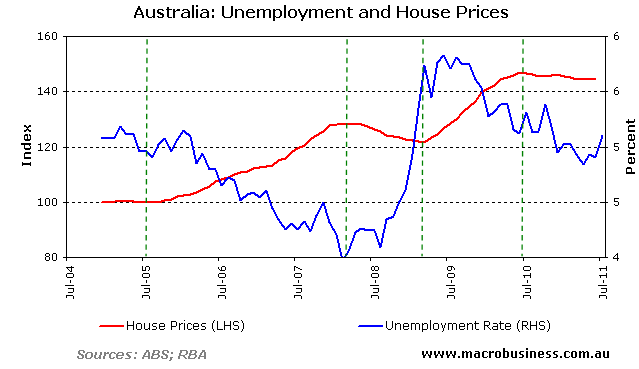
While one month’s unemployment data certainly does not represent a trend, and the unemployment rate could just as easily reverse next month (particularly given the large sampling error), the data as it exists currently tentatively supports the hypothesis that the unemployment rate lags house price growth.
The reasons behind this hypothesis have been explained previously (for example, here and here). In a nutshell, changes in housing values are a leading determinant of household consumption expenditure, consumer confidence, employment and growth. This is because when house prices rise (fall) in value, households feel wealthier (poorer) spurring consumer confidence (pessimism), spending (saving) and employment growth (job losses).
The housing ‘wealth effect’ can be seen from the below charts showing how changes in real private consumption has tracked the changes in real house prices very closely.
First, there’s this spectacular chart from the ANZ Bank’s New Zealand economics team confirming the housing “wealth effect” in a very explicit way for New Zealand:
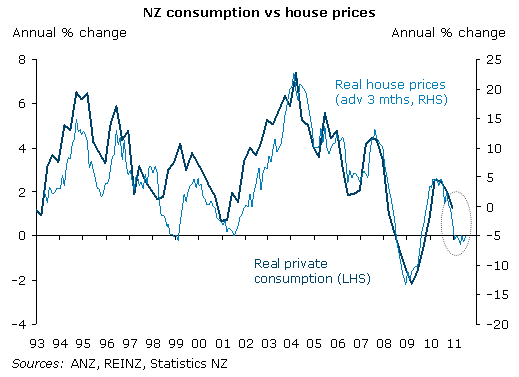
And this chart from Deloitte shows a similar relationship between house prices and consumption in the UK:
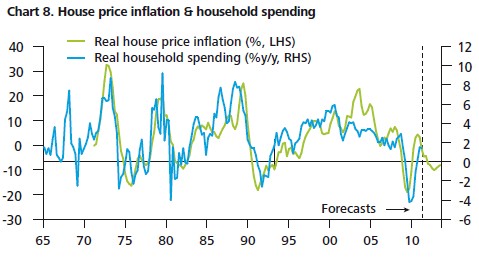
Finally, there’s my attempt at recreating the above charts for Australia:
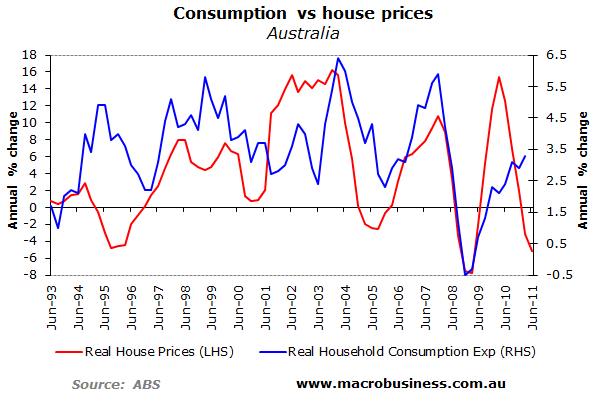
Granted, my chart is not as sexy as the others, but it still reveals a high correlation between changes in real house prices and changes in real household consumption expenditure, thereby suggesting that the wealth effect is in play.
In what could be an ominous sign for Australian retailers, the decline in real home prices over the past year has yet to be reflected in the household consumption figures, which have yet to turn down from their post-GFC bounce. If the recent correlation between home values and household consumption holds, then Australian retailers could face several quarters of declining sales growth ahead.
And to make matters worse for retailing, Delusional Economics recently showed that mortgage credit growth usually leads house prices by up to six months. So with mortgage credit growth having fallen recently (see below chart), Australia can expect further house price weakness, which should also depress household consumption and retail sales going forward.
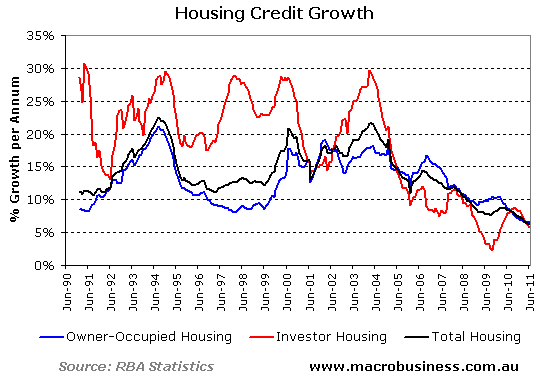
Therefore, household consumption and retail sales are likely to remain subdued relative to the pre-GFC norm, thanks in no small part to household disleveraging and the sluggish state of the nation’s housing markets.
Ultimately, this weakness in consumption is likely to result in further job losses and a move upwards in Australia’s unemployment rate.

